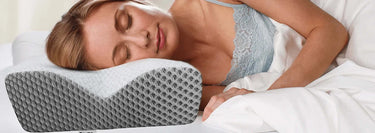Understanding How Foam Density Shapes Stability and Balanced Elevation
Table of Contents
- What Foam Density Means In Ergonomic Support
- How Foam Density Shapes Elevation Stability
- Response Behavior: How Foam Reacts Over Time
- Density, Angles, And Alignment Working Together
- Comparing Low, Medium, And High-Density Foams
- Temperature, Rebound Timing, And Session Consistency
- Daily Routines Where Density Makes A Noticeable Difference
- How Zen Bloks Uses Foam Density Inside The Rest Ease Wedge
- Glossary: Key Foam And Support Terms
- Compliance Note
What Foam Density Means In Ergonomic Support

In ergonomic elevation products, foam density is one of the core variables that decides whether support feels stable, structured, and predictable. Density is not how hard or soft foam thinks in the first five seconds. It is a measure of how much material exists in a given volume, and how that structure responds when weight settles in.
For a leg elevation wedge, the question is simple. When someone settles their legs on the incline, does the wedge maintain its shape and angle, or does the support flatten and tilt in ways that shift alignment? Density is the silent factor that controls the outcome.
High-density, high-quality memory foam uses a tighter internal structure. The material has more mass and more connected cells per cubic unit. When weight is applied, that structure resists collapse, compresses in a controlled pattern, and then recovers in a consistent time frame. In ergonomic terms, it supports alignment instead of allowing gradual sagging.

(Above) This diagram (magnified) shows a magnified cross-section of how foam density affects structural behavior inside a wedge. The left side illustrates low-density foam with larger, irregular open cells that compress more easily and lose shape faster. The right side shows high-density foam with smaller, more uniform cells that resist compression and maintain stability under load. This visual highlights why higher-density materials provide more consistent elevation and long-term support.
Low-density foam, by contrast, contains more void space and fewer supporting cell walls. It can feel comfortable at first because it compresses very quickly. Over a full session, that same quick collapse often turns into uneven sink, angle loss, and drifting contact points along the legs and hips.
This is why density belongs in the same conversation as angle design. Angles define the intended posture. Density determines whether that posture stays stable through real daily use.
Density is not the same as firmness.

Firmness describes how foam feels at the surface when pressure is applied. Two foams can share similar initial firmness while having very different densities. The higher-density material will usually hold its shape better over longer sessions because more material is available to share and distribute the load.
Foam Fatigue Diagram Below if Low Quality Foam is Used.

(Above) This diagram shows why a firm, structured wedge like Zen Bloks® performs better both immediately and in the long term.
1. Consistent Body Positioning with High Qualtiy Foam
The top image shows how your legs rest on the wedge. A firm incline keeps your alignment predictable from day one. The initial ramp supports the lower leg, the knee curve guides the bend naturally, and the upper platform holds the thigh without sinking. When the foam is too soft, the shape distorts under load, your legs slide deeper into the wedge, and your alignment changes from session to session. A firm, structured design prevents this drift, so your body settles into the same stable position each time, helping reduce unnecessary strain and tension in the lower back and hips.
2. Long-Term Structural Integrity High Quality Leg Wedge Foam
The bottom sequence (Elastic Phase → Fatigue Onset → Wall Failure) illustrates what happens inside low-density foam over time.
Cheap foam compresses too easily. Its cell walls flex beyond their elastic limit, fatigue develops with repeated use, and eventually the structure collapses. Once the walls fail, the foam no longer rebounds, the profile changes, and the wedge permanently sags at the apex.
Zen Bloks® uses controlled-density ergonomic foam designed to avoid this breakdown. The internal cell walls remain within their elastic range, so the wedge keeps its shape, angle, and support even after years of use. This is why Zen Bloks® remain stable long after low-density wedges have collapsed.
For an elevation wedge that supports the full length of the lower body, this separation matters. The goal is not a hard block or a soft cushion. The goal is a structured surface that holds its angles, evenly supports the legs, and helps the hips and spine settle into balanced alignment.
How Foam Density Shapes Elevation Stability

Elevation stability describes how well a wedge maintains height, angle, and contour while in use. Foam density directly influences all three. When density is selected properly, support remains consistent from the moment someone settles into position to the moment they step away.
Load distribution across the wedge
When someone rests their legs on a wedge, weight does not land in one place. It travels from heel to calf, through the knee zone, and into the upper leg. A high-density core helps distribute that load, preventing one region from collapsing faster than another.
If the knee region compresses more than the calf region, the angle between the thigh and torso changes. If the upper incline flattens, the legs drift into a lower position than intended. Both outcomes shift alignment and reintroduce tension that structured elevation was meant to reduce.
A well specified density profile resists these localized dips. The wedge stays closer to its designed contour, and weight spreads across the surface instead of sinking into a single channel.
How density controls drift and sag

(Above) This chart compares how different types of foam rebound when weight is removed. The slow-response curve shows gradual recovery, which can feel lagged and less stable. The controlled-response curve rises quickly and then levels off, indicating a faster, more adaptive return to shape. This behavior helps the wedge maintain consistent elevation during repositioning and regular use.
Drift occurs when legs gradually slide down or rotate outward during a session. Sag occurs when foam in the central region flattens while the edges stay higher. Both are signs that density and structural support are misaligned with the real loads placed on the wedge.
Higher-density memory foam resists this behavior. It compresses in a more uniform pattern from edge to center. As a result, the incline profile stays closer to the original shape. The user feels supported rather than pulled down the slope, and the wedge behaves like a resting platform instead of a soft ramp.

(Above) This diagram compares how different foam densities behave under regular use. Lower-density foam compresses quickly and loses structure faster, which can feel uneven during elevation. Medium density offers better consistency, but still changes shape more noticeably over time. Ergonomic-grade density—used in the Zen Bloks wedge—keeps its form under load, giving you a more stable, predictable surface for leg elevation. This density profile is what maintains the wedge’s smooth knee curve and upper platform shape during everyday use.
Micro movements and tension patterns

(Above) This diagram illustrates how the load is distributed across the wedge when the legs rest at the designed elevation angle. Most of the force settles into the knee-curve apex, where the leg naturally bends. This is the highest structural demand point, which is why the foam density transitions upward in this region. As the load spreads down the ramp, pressure decreases gradually, creating smoother contact and consistent support along the lower leg.
When support starts to sag, the body adapts through subtle muscle activation and slight shifts in position. The person may not notice each change, but the cumulative effect is more tension and less relaxation. High-density, high-quality foam limits these micro adjustments because the foundation beneath the legs remains stable.
From an ergonomic perspective, this stability supports better posture and more effective daily reset sessions. The wedge behaves as intended, rather than changing shape over time during use.
Response Behavior: How Foam Reacts Over Time
Foam density is only half of the equation. The other half is response behavior how the material changes under load and how it returns to its original form when weight is removed. Memory foam is known for its slower recovery profile, which can be an advantage when tuned correctly.
Phase 1: Initial compression
The first phase begins as soon as weight is applied. In a well-engineered wedge, the foam compresses enough to contour around the leg, but not so far that angles drop significantly. High-density memory foam moves through this phase gradually. It accepts load, shifts air and material internally, and then reaches a stable compressed state.
Low density foam usually compresses too quickly in this phase. The material can bottom out under higher load, especially in the center of the wedge where more weight is concentrated. Once bottoming occurs, the wedge stops behaving like a shaped ergonomic support and starts behaving more like a thin pad over a solid base.
Phase 2: Sustained load
The second phase is where density and response behavior decide long term comfort. During a 20 to 40 minute elevation session, the foam structure must resist progressive collapse. High density foam uses stronger cell walls and more internal support points. Instead of continuing to sink, it reaches an equilibrium where compression stabilizes.
If density is too low, the foam can continue creeping under load. Every few minutes, the user sinks slightly deeper, changing angles and creating new pressure lines. This creeping effect is often subtle, but it is easy to recognize in the imprint that remains after the session.
Phase 3: Recovery and structural reset
Once weight is removed, the foam moves through the recovery phase. High density memory foam regains its shape slowly and predictably. This predictable rebound timing helps maintain long term structural integrity. The wedge returns to its original contour instead of staying compressed or developing a permanent dip.
If foam does not recover well, each session leaves a little more imprint behind. Over weeks and months, the wedge loses height and angle accuracy. At that point, even the best geometric design cannot deliver its intended alignment because the structure underneath has changed.
Density, Angles, And Alignment Working Together

This page sits in a cluster with two other authority explainer pages:
Angles define the theoretical alignment path from heel to hip. Density and response behavior decide whether that path holds up under real use. Without proper density, even an ideal incline can flatten, rotate, or deform in ways that shift posture away from the intended target.
(Below) This diagram shows what happens when a leg wedge is built with low-density, low-stability foam. The material can’t maintain its shape under repeated body weight, so it slowly collapses over time.

-
Original Profile (Unloaded)
The wedge starts with its intended shape, but low-density foam has a weak internal cell structure. It only holds this profile when no weight is applied. -
Temporary Deformation (Loaded)
Once weight is applied, the foam compresses deeper than it should. The cells bend, stretch, and fold instead of distributing the load. In good foam, this temporary deformation rebounds cleanly. In low-density foam, it struggles to recover. -
Permanent Set (After Repeated Cycles)
Over time the foam reaches a point where the structure can’t return to its original form. A permanent dip forms in the knee curve or upper platform. This is called “permanent set,” and it happens when the material breaks down from repeated compression.
The result is a wedge that loses its angle, loses its support behavior, and feels unstable. This is exactly why high-density ergonomic-grade foam is non-negotiable for keeping the wedge’s elevation consistent week after week.
Angle preservation under real load
When a wedge is designed with a specific degree of incline, the expectation is that this angle will be present during use, not only in technical drawings. High-density foam helps preserve this angle by limiting how far the apex and central zones compress under the combined weight of both legs.
If the center compresses significantly more than the edges, the effective incline becomes shallower, and the user loses elevation height. This can reduce the perceived benefit of the session, not because elevation as a concept is weak, but because the underlying structure is not preserving the intended orientation.
The alignment chain: foot, knee, hip, lumbar
The lower body behaves as a linked chain of segments. When the wedge supports the legs in a consistent pattern, the foot, knee, hip, and lower back align in a more balanced way. Foam density supports this chain by preventing isolated collapse zones that tilt one joint relative to another.
Good density specification ensures that the wedge does not create a hinge at the knee, a dip under the calves, or an unexpected drop under the thighs. Instead, the entire incline supports the chain as a connected system.
Comparing Low, Medium, And High Density Foams
The table below summarizes how different density ranges behave in an elevation wedge environment. Values are generalized for clarity rather than exact specifications.
| Foam Density Range | Typical Response | Elevation Stability | Session Experience | Long Term Shape Retention |
|---|---|---|---|---|
| Low Density | Compresses quickly, soft initial feel | Prone to sagging and angle loss | Legs may drift, center can feel “hollow” over time | Higher risk of permanent dips and flattening |
| Medium Density | Balanced contour, moderate resistance | Better angle retention under typical use | More predictable support for shorter sessions | Reasonable shape retention with moderate use |
| High Density Memory Foam | Controlled compression, slower response | Strong resistance to sagging, stable incline | Consistent support across full session duration | Better preservation of height and contour across months and years |
Zen Bloks selects density tiers aimed at the high stability end of this range. The goal is not to chase hardness, but to maintain structural consistency so angles and alignment behave as engineered, even as the wedge is used regularly as part of daily routines.
Temperature, Rebound Timing, And Session Consistency
Memory foam is known for being temperature responsive. As it warms slightly under body contact, the material softens and conforms more closely to the shape above it. This can be an ergonomic advantage when tuned correctly, because it spreads pressure more evenly and creates a cradle effect without sacrificing overall height.
Temperature behavior and contouring
In a high density formulation, temperature responsiveness works in a controlled band. The foam adapts to the shape of the legs while still holding its overall incline. The contour deepens slightly where contact is heaviest, but the wedge does not collapse fully in those regions.
When density is too low, temperature softening accelerates collapse. As the session continues, the foam can lose stiffness more quickly in key zones such as under the knees, which are often the heaviest contact points. This creates an uneven cradle that changes alignment.
Rebound timing between sessions
High density memory foam is designed to recover to its original profile between uses. The time it takes to regain full height is part of the broader topic of rebound timing. When this timing is consistent, the user can count on the wedge feeling the same in the evening as it did the previous night.
If foam rebounds unpredictably, one session may start on a partially compressed surface while another starts on a fresh profile. That kind of variation erodes trust in the support. Zen Bloks uses density profiles and response tuning that promote reliable recovery, so each elevation session starts from a known baseline.
Daily Routines Where Density Makes A Noticeable Difference
Foam density and response behavior matter most during real routines, not in lab charts. The following scenarios show where the right density profile supports more comfortable, predictable sessions.
Evening reset after long sitting periods
Many people use leg elevation as part of an evening reset after a day at a desk, in a vehicle, or on their feet. In that window, high density foam helps the wedge feel like a stable platform instead of a soft surface that sinks throughout the session.
With proper density, the legs remain at roughly the same height from the start of the session to the end. The body can relax into the position without ongoing adjustments. This stability supports a sense of lightness in the legs and less overall tension across the lower body.
Reading, streaming, and extended screen time
During reading or streaming sessions, people often stay elevated for longer stretches. Density has a direct impact on how comfortable this feels after the first 20 minutes. Low density foam may feel inviting at the beginning, then gradually lose structure. High density foam keeps the experience more consistent, which helps keep posture balanced and reduces the tendency to twist or slump as support changes.
Short reset breaks throughout the day
Some users prefer shorter, more frequent elevation sessions. For this style of use, rebound timing and structural reset are critical. The wedge needs to recover between sessions so the next break starts from the correct height and contour. High density foam with tuned response behavior supports this rhythm, since the material is engineered to return to its neutral state reliably.
How Zen Bloks Uses Foam Density Inside The Rest Ease Wedge
Zen Bloks positions density, angle design, and contour shaping as a single system. The Rest Ease Leg Elevation Wedge uses high quality memory foam selected for structural stability, not trend driven softness alone.
Density as a primary design input
The wedge is engineered around target angles and elevation height. From there, density is chosen to protect those angles under real world load. This is a different process from selecting a generic foam block and shaping it into a wedge profile.
By treating density as a design input rather than a secondary specification, Zen Bloks aligns foam behavior with the ergonomic goals of the product. The result is an incline that resists sagging and maintains the intended orientation across full leg length.
Integration with broader ergonomic design
Foam density and response behavior are explained in more detail and in context on the brand’s design overview page:
Zen Bloks Ergonomic Design: How Structure Supports Everyday Comfort
Together with the pages on angle science and incline engineering, this foam density page completes a core part of the Ergonomic Science and Angles cluster. Users can move from angle theory, to incline design, to density behavior, and see how each element supports the same outcome: stable, predictable elevation for real daily use.
Bring Structured Foam Density Into Your Daily Reset
If you want elevation support that holds shape through full sessions, density and response behavior matter as much as angle. The Rest Ease Leg Elevation Wedge is built around these principles so your routines feel more stable, supported, and repeatable night after night.
Glossary: Key Foam And Support Terms
- Foam density
- The amount of material mass per unit volume inside a foam block. Higher density usually means more supporting cell walls and stronger resistance to collapse under load.
- Response behavior
- The way foam reacts when weight is applied and removed. This includes how quickly it compresses, how it distributes load, and how it returns to its original shape.
- Rebound timing
- The time it takes foam to recover its original height and contour after load is removed. Consistent rebound timing supports repeatable session quality.
- Elevation stability
- The ability of a wedge or cushion to maintain its height, angle, and contour during a complete use period without sagging or drifting.
- Structural integrity
- The capacity of the foam and wedge shape to resist permanent deformation and maintain design geometry across extended use.
Compliance Note
Zen Bloks products, including the Rest Ease Leg Elevation Wedge, are designed for ergonomic support, posture balance, and everyday comfort. They are not medical devices and are not intended to diagnose, treat, cure, or prevent any medical condition. For questions about health concerns or specific conditions, consult a qualified healthcare professional.





